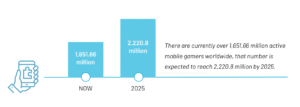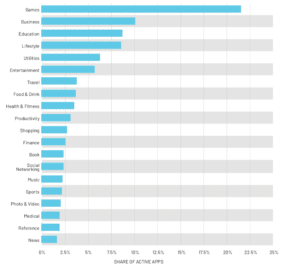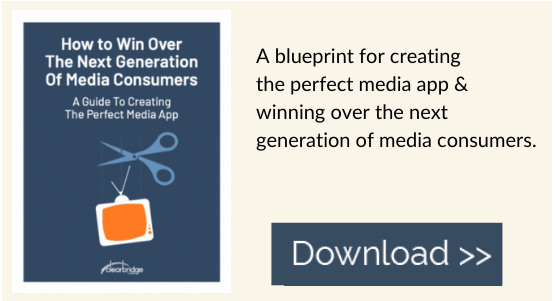This is an excerpt from our e-book: The Ultimate Guide To New Streaming & Media App Engagement Strategies. Download the full version here
As the mobile app market continues to grow rapidly, it’s becoming harder for app developers and organizations to stand out amongst competitors and grab their share of the market space. In particular, the market for video streaming and OTT apps has become over-saturated although run by significant players. While most of these apps target millennials and generation Z, it is precisely this audience that tends to tire of things easily. Therefore these apps must offer users something exciting and challenging to keep them constantly engaged, and mobile app gamification is one of the most potent user engagement methods.
We can easily find examples of gamification throughout our daily and professional lives. For example, teachers reward students with stickers or retail stores offering customers rewards programs that enable them to get a free product after a set amount of purchases. The fact that gamification is so ingrained in our daily lives makes it a compelling engagement method for mobile OTT apps.
With such an active user base, it’s no surprise that games remain far ahead of other Apple App Store categories in 2021. Specifically, 21.53 percent of the most popular Apple App Store categories in March 2021 belong to the gaming category, followed by business, which is only 10.11 percent.
Therefore, it is understandable why many other types of apps are actively dedicating resources to introducing gamification elements and gaming features (i.e., badges, rewards, points, scoreboards, internal currency, levels, etc.) to their apps.
Why Is Mobile App Gamification Important?
Before you decide to add gamification elements to your OTT app, you would want to learn which benefits mobile app gamification will bring to your business and how it can help you increase user engagement.
Mobile app gamification works because it has the power to trigger various human emotions. A 1998 study by Matthias Koepp, a neurology professor at the University College London Queen Square Institute of Neurology, found that as adult players progressed through a video game and encountered more complex challenges, their brains released more dopamine. Based on this, it’s safe to conclude that if gaming elements similar to those that would be found in a video game, for example, are applied to a non-gaming mobile app, a similar effect of having users’ brains release dopamine would occur. As a result, they want to interact with the gamified app longer to get more achievements and enjoy the feeling of accomplishment.
Additionally, here’s how mobile app gamification can influence and motivate people:
- It awakens curiosity. Curiosity helps to encourage users, so they can move forward and get more rewards.
- It fosters competition. Scoreboards with the achievements of other users encourage the players to accomplish more and compare their results with others.
- It creates a sense of control. No one likes to be forced to do something. That is why the critical purpose of gamification is to give the users control and decide which milestone they will complete next.
We can look at Netflix as an example with the choose-your-own-adventure episode “Bandersnatch” of the series Black Mirror where viewers are asked to pick between two choices as they go through the episode, then control over how the plot unfolds. This results in multiple “endings” and many story paths resulting from millions of unique permutations. To add even more gamification elements, Netflix included a countdown timer to ensure viewers decide within a certain period. According to Netflix, more than 90 percent of viewers engaged with the “choose your own adventure” story from the very first option.
How Do You Gamify An App?
To implement gamification in your app, you need to start with the design elements and then proceed with the mobile app gamification workflow. The typical design elements include:
- Badges: These are a visual representation of users’ achievements, which indicate their performance within the app. For example, some fitness apps like Peloton introduce badges to help encourage and motivate people to work out together. With Peloton, users can take a “ride” with others they are connected with on Peloton to achieve the following badges: Dynamic Duo (ride with one other person from your list), Three’s Company (3), Pack (4), Squad (5), Flock (10), Swarm(20+).
- Levels. These are the parts of the game world. With each level, the complexity of the game increases, challenging the user to get further. The Netflix example above would fall into this category, as the choices users were presented with more ethically complex decisions.
- Performance charts show how the player performed compared to their previous results and track their records.
- Points: These are basic rewards that the user gets for their accomplishments as they progress within the game.
- Scoreboards: These are lists with player rankings that help to define who performs best in a specific activity. Unlike performance charts that show the performance of one user within a specific period, a scoreboard shows the performance concerning the performance of others.
- In-game currency: This is the means of “payment” for game-related benefits — extra lives, for example. This element works best for live sports streaming apps where online sports betting may be involved. The user can get this currency as a reward for specific accomplishments or as a daily bonus.
Successfully implementing mobile app gamification elements into your app requires more than just design and development. To ensure the gamification elements you implement truly engage and help to retain more users:
- Keep in mind the problem that needs to be solved with gamification. For example, the app is not getting the desired level of conversion. We recommend that you implement the gaming elements and align those elements with your corporate goals.
- Incorporate social elements. The most remarkable feature of gamification is its ability to drive groups of people together in collaboration and socializing. The gamified app should be designed in a way that encourages and rewards social networking.
- Keep everything simple. Mobile app gamification is all about fun and simplicity so that the user intuitively understands at which stage they currently are and what they should do next. Your task here is to walk the user through each step smoothly and transparently.
- Develop an easy-to-use reward system. Instead of promising One Big Reward at the end of the game, break it down into smaller chunks and offer small rewards upon the completion of each piece.





